|
E language
E (IPA: [ɛ55], English approximation: EH), also known as Ei, Wuse, or Wusehua, (simplified Chinese: 五色话; traditional Chinese: 五色話; pinyin: Wǔsèhuà; lit. 'colored language') is a Tai–Chinese mixed language spoken primarily in Rongshui Miao Autonomous County, Guangxi, China. It contains features of both Tai and Chinese varieties, generally adopting Chinese vocabulary into Tai grammar. E is a tonal language—distinguishing between seven tones—and contains a few rare phonemes: voiceless versions of the more common nasal consonants and alveolar lateral approximant. EtymologyThe E language's unusual name, which is also an autonym, derives from the pinyin transliteration of the rare Mandarin syllable 诶; 誒; ê̄ (IPA: [ɛ55]), which conventionally denotes an expression of affirmation (and is distinguished from ē in pinyin by the use of a circumflex).[2][3] The language's speakers also refer to their language as Kjang E [kiaŋ55 ɛ55].[2] Wusehua is a derogatory name for E.[4] Geographical distribution In 1992, E was spoken by about 30,000 people,[5][2] but by 2008 this number had dwindled to 9,000.[6] Gao (2016) reported that there were 5,000 speakers of E.[1] Most E speakers are classified as Zhuang by the Chinese government. E speakers live in Rongshui Miao Autonomous County and border areas of Luocheng Mulao Autonomous County in Guangxi. In Rongshui County, the three main villages inhabited by E speakers are Xiatan 下覃村, Simo 四莫村, and Xinglong 兴隆村 in Yongle Township 永乐乡.[1] E speakers' most commonly spoken other languages are the Liujia dialect (六甲话) of Yue Chinese and the Guiliu variant of Southwestern Mandarin.[1] PhonologyE's consonant and vowel inventories are mostly similar to those of its parent languages. However, it contains a few unusual consonants: the voiceless nasal consonants [n̥], [ŋ̥], [m̥], and the voiceless alveolar lateral approximant [l̥]. All are voiceless versions of consonants that, in most languages, are always voiced. E allows syllabic consonants and diphthongs.[6]
Like most Southeast Asian languages, including Tai and the varieties of Chinese, E is tonal.[7] The language is described as having seven tones, with the seventh varying allophonically with the length of the vowel it is attached to. With numbers ranging from 1 to 5, with 1 being the lowest tone and 5 the highest, the contours of the various tones in E are as follows.[6]
Grammar and lexiconE is usually classified as a mixed language deriving ultimately from the Tai-Kadai and Sino-Tibetan families, which both inhabit southern China and Southeast Asia.[4] Some non-Chinese scholars, however, consider it a Tai-Kadai language with Chinese influence.[8] Whatever its classification, the grammar resembles that of the Tai branch of Tai-Kadai. E's grammatical features appear to be a mix of Northern Zhuang, Mulam, and Kam.[1][7] The Caolan language of Vietnam also displays many similarities with E.[7] The vocabulary, however, is mostly Chinese, based on Guiliu and the Tuguai variant of Pinghua.[1][7] Out of the 2,000 most commonly used E words, only about 200 are of Tai-Kadai origin.[9] E also inherits elements of these Chinese dialects' phonology and compound word formation.[1] E morphology is primarily analytic, with concepts such as negation expressed with auxiliary words (pat6, m2) and no pronominal agreement.[6] In its pronouns, E distinguishes for person between first, second, and third; in number between singular and plural; and, in the case of the first-person plural, between inclusive and exclusive we. E does not, however, make distinctions for grammatical gender.[6]
Notes
References
|
|||||||||||||||||||||||||||||||||||||||||||||||||||||||||||||||||||||||||||||||||||||||||||||||||||||||||||||||||||||||||||||||||||||||||||||||||||||||||||||||||||||||||||||||||||||||||||||||||
